Geology and Hydrothermal Evolution of the Antas North Iron Sulfide–Copper–Gold (ISCG) Deposit in the Carajás Mineral Province
Abstract
1. Introduction
2. Geological Background
3. IOCG Deposits in the Carajás Province
- Metavolcano-sedimentary host rocks from the Itacaiúnas Supergroup;
- Strong structural control, often associated with shear zones;
- Proximity to diverse intrusive suites (granite, diorite, gabbro);
- Abundant hydrothermal breccias;
- Intense sodic, potassic, and magnetite alterations;
- Polymetallic enrichment (REE, P, U, Ni, W, Sn, Co, Pd);
- Wide variation in formation temperatures (100–570 °C) and salinities (0–69 wt.% NaCl eq.).
4. Materials and Methods
4.1. Fieldwork, Petrography, and Structural Geology
4.2. U–Pb Titanite Geochronology
5. Local Geology
5.1. Host Rocks
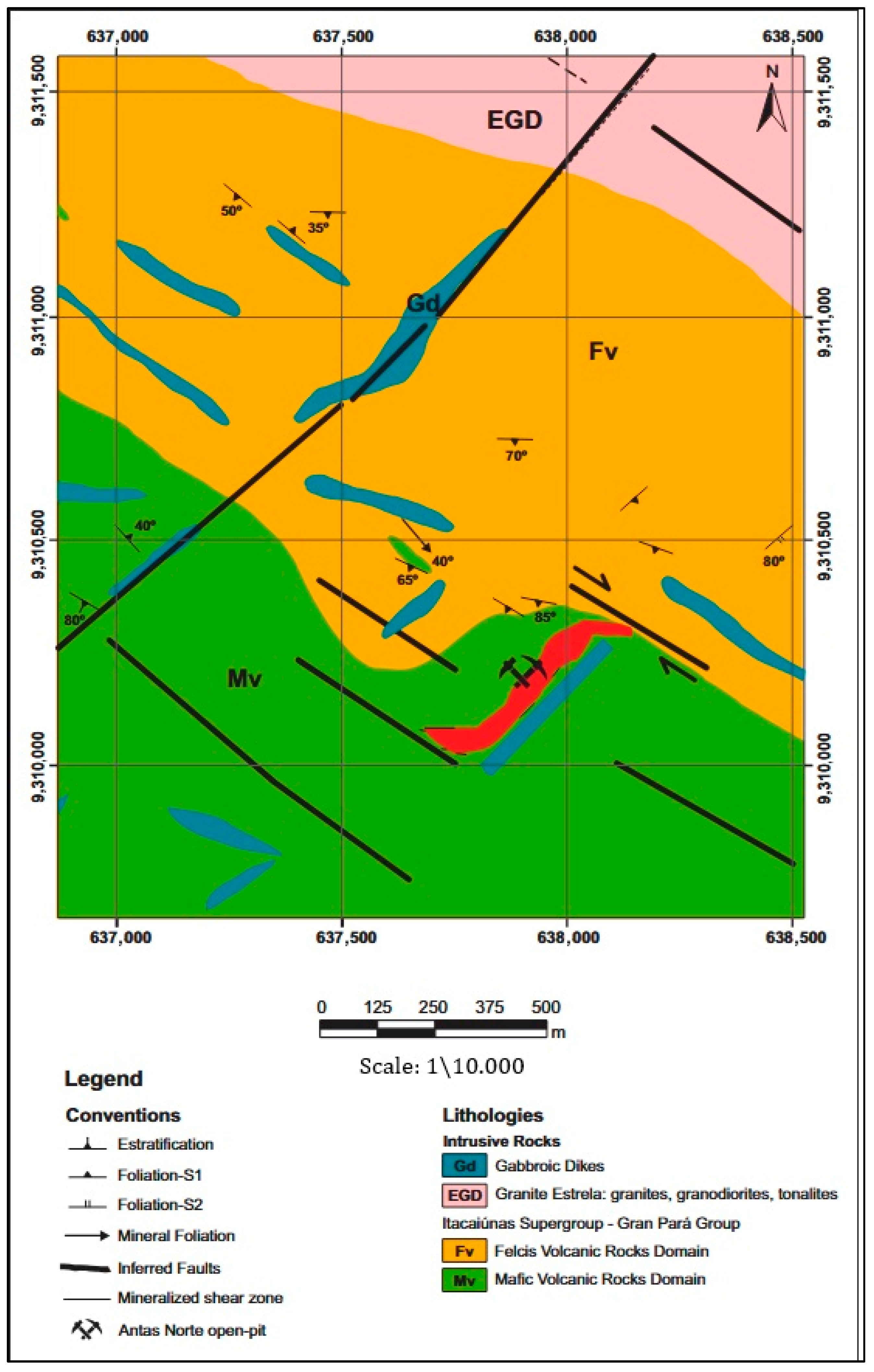
5.2. Felsic Volcanic Rocks
5.3. Gabbro Dikes
6. Hydrothermal Alterations
- Sodic alteration—dominated by pervasive albite replacement of feldspar and mafic minerals; quartz and ilmenite may accompany albite. This stage occurs mainly in felsic metavolcanic rocks away from the ore zone.
- Potassic alteration—characterised by the growth of brown biotite and turbid scapolite replacing amphiboles and feldspars. Scapolite occurs as cloudy porphyroblasts and may be difficult to identify in thin section. Potassic alteration is centred around mineralized zones and overprints sodic assemblages.
- Calcic alteration—marked by the development of green amphibole (magnesiohornblende to actinolite) and apatite, often with minor allanite. Actinolite forms fibrous rims around hornblende cores, reflecting decreasing temperature. This stage is closely associated with copper mineralization and often obliterates earlier fabrics.
- Silicification—pervasive quartz veining and replacement that can occur throughout the hydrothermal system. Silicification overprints sodic, potassic and calcic assemblages and is especially common along brittle fractures.
- Propylitic alteration—characterised by chlorite, epidote and calcite, typically developed in the distal portions of the system and along the margins of mineralized breccias. Propylitic alteration is a late overprint reflecting cooler, more oxidizing fluid conditions and may be subtle in thin section due to overprinting by surface weathering (9).
7. Mineralization
8. Geochronology
9. Structural Framework and Distribution of Hydrothermal Alteration
- Sn foliation: a pervasive mylonitic fabric defined by the preferred orientation of amphiboles, plagioclase, and biotite, trending NNE–SSW and dipping ESE.
- Sn + 1 foliation: a younger foliation formed during shearing and hydrothermal overprint, marked by oriented amphiboles and biotite around quartz and feldspar porphyroclasts, trending ENE–WSW and dipping SSE.
10. Discussion
10.1. Structural Framework and Ore Controls
10.2. Hydrothermal Evolution and Alteration Zonation
10.3. Redox State and Mineralogical Implications
10.4. Geochronological Constraints and Metallogenic Significance
- 2476.6 ± 15.9 Ma (2σ, n = 24, MSWD = 3.77)—a late Archean hydrothermal stage synchronous with Cu–Au mineralization.
- 2162.9 ± 28.1 Ma (2σ, n = 5, MSWD = 0.86)—Paleoproterozoic reactivation during the Transamazonian orogeny.
10.5. Broader Implications for IOCG–ISCG–IOA Systems
11. Conclusions
Author Contributions
Funding
Data Availability Statement
Acknowledgments
Conflicts of Interest
References
- Araújo, O.J.B.; Maia, R.G.N. Serra dos Carajás, Folha SB.22-ZA, Estado do Pará. Programa Levantamentos Geológicos Básicos do Brasil; Companhia de Pesquisa de Recursos Minerais: Manaus, Amazonas, 1991; Volume 136. [Google Scholar]
- Hühn, S.R.B.; Nascimento, J.A.S. São os depósitos cupríferos de Carajás do tipo Cu-Au-U-ETR? In Contribuições à Geologia da Amazônia; Costa, M.L., Angélica, R.S., Eds.; FINEP, SGB-NO; Sociedade Brasileira de Geologia: São Paulo, Brazil, 1997; pp. 143–160. [Google Scholar]
- Grainger, C.J.; Groves, D.I.; Tallarico, F.H.B.; Fletcher, I.R. Metallogenesis of the Carajás Mineral Province, Southern Amazon Craton, Brazil: Varying styles of Archean through Paleoproterozoic to Neoproterozoic base- and precious-metal mineralization. Ore Geol. Rev. 2008, 33, 451–489. [Google Scholar]
- Monteiro, L.V.S.; Xavier, R.P.; Hitzman, M.W.; Juliani, C.; Souza Filho, C.R.; Carvalho, E.R. Mineral chemistry of ore and hydrothermal alteration at the Sossego iron oxide–copper–gold deposit, Carajás Mineral Province, Brazil. Ore Geol. Rev. 2008, 34, 317–336. [Google Scholar]
- Monteiro, L.V.S.; Xavier, R.P.; Carvalho, E.R.; Hitzman, M.W.; Johnson, C.A.; Souza Filho, C.R.; Torresi, I. Spatial and temporal zoning of hydrothermal alteration and mineralization in the Sossego iron oxide-copper-gold deposit, Carajás Mineral Province, Brazil: Paragenesis and stable isotope constraints. Miner. Depos. 2008, 43, 129–159. [Google Scholar] [CrossRef]
- Xavier, R.P.; Monteiro, L.V.S.; Souza Filho, C.R.; Torresi, I.; Carvalho, E.R.; Dreher, A.M.; Wiedenbeck, M.; Trumbull, R.B.; Pestilho, A.L.S.; Moreto, C.P.N. The iron oxide copper-gold deposits of the Carajás Mineral Province, Brazil: An updated and critical review. In Hydrothermal Iron Oxide Copper-Gold & Related Deposits: A Global Perspective; Porter, T.M., Ed.; PGS Publishing: Adelaide, Brazil, 2010; Volume 3, pp. 285–306. [Google Scholar]
- Xavier, R.P.; Monteiro, L.V.S.; Moreto, C.P.N.; Pestilho, A.L.S.; Melo, G.H.C.; Silva, M.A.D.; Aires, B.; Ribeiro, C.; Silva, F.H.F. The Iron Oxide Copper-Gold Systems of the Carajás Mineral Province, Brazil. In Geology and Genesis of Major Copper Deposits and Districts of the World: A Tribute to Richard Sillitoe; Society of Economic Geologists: Littleton, CO, USA, 2012. [Google Scholar]
- Pollard, P.J.; Taylor, R.G.; Peters, L.; Matos, F.; Freitas, C.; Saboia, L.; Huhn, S.R.B. 40Ar/39Ar dating of Archean iron oxide Cu-Au and Paleoproterozoic granite-related Cu-Au deposits in the Carajás Mineral Province, Brazil: Implications for genetic models. Miner. Depos. 2019, 54, 329–346. [Google Scholar]
- Palma, G.; Barra Pantoja, F.; Reich Morales, M.; Simon, A.C.; Romero, R. A review of magnetite geochemistry of Chilean iron oxide-apatite (IOA) deposits and its implications for ore-forming processes. Ore Geol. Rev. 2020, 126, 103748. [Google Scholar] [CrossRef]
- Reich, M.; Simon, A.C.; Barra, F.; Palma, G.; Chiaradia, M.; Deditius, A.; Roberts, M.; Tornos, F.; Velásquez, G.; Wilkinson, J.J. Formation of iron oxide–apatite deposits. Nat. Rev. Earth Environ. 2022, 3, 758–775. [Google Scholar] [CrossRef]
- Skirrow, R.G.; Murr, J.; Schofield, A.; Huston, D.L.; Van der Wielen, S.; Czarnota, K.; Coghlan, R.; Highet, L.M.; Connolly, D.; Doublier, M.; et al. Mapping iron oxide Cu-Au (IOCG) mineral potential in Australia using a knowledge-driven mineral systems-based approach. Ore Geol. Rev. 2019, 113, 103011. [Google Scholar] [CrossRef]
- Skirrow, R.G. Iron oxide copper-gold (IOCG) deposits—A review (part 1): Settings, mineralogy, ore geochemistry and classification. Ore Geol. Rev. 2022, 140, 104569, ISSN 0169-1368. [Google Scholar] [CrossRef]
- Araújo, O.J.B.; Maia, R.G.N.; Jorge-João, X.S.; Costa, J.B.S. A Megaestruturação da Folha Serra dos Carajás. In Proceedings of the VII Congresso Latino-Americano de Geologia, Belém, Brazil, 6–13 September 1988; pp. 324–333. [Google Scholar]
- Pinheiro, R.V.L.; Holdsworth, R.E. Reactivation of Archean strike-slip fault systems, Amazon region, Brazil. J. Geol. Soc. 1997, 154, 99–103. [Google Scholar]
- Pinheiro, R.V.L.; Holdsworth, R.E. Evolução tectonoestratigráfica dos sistemas transcorrentes Carajás e Cinzento, Cinturão Itacaiúnas, na borda leste do Cráton Amazônico. Pará. Rev. Bras. Geociênc. 2000, 30, 597–606. [Google Scholar] [CrossRef]
- Haddad-Martim, P.M.; Souza Filho, C.R.; Carranza, E.J.M. Spatial analysis of mineral deposit distribution: A review of methods and implications for structural controls on iron oxide-copper-gold mineralization in Carajás, Brazil. Ore Geol. Rev. 2017, 81, 230–244. [Google Scholar] [CrossRef]
- Hirata, W.K.; Rigon, J.C.; Kadekaru, K.; Cordeiro, A.A.C.; Meireles, E.A. Geologia Regional da Província Mineral de Carajás. In Proceedings of the I Simpósio de Geologia da Amazônia, Belém, Brazil, 25–31 May 1982; pp. 100–110. [Google Scholar]
- Wirth, K.R.; Gibbs, A.K.; Olszewski, W.J., Jr. U-Pb ages of zircons from the Grão Pará Group and Serra dos Carajás granite, Pará, Brasil. Rev. Bras. Geociênc. 1986, 16, 195–200. [Google Scholar] [CrossRef]
- Machado, N.; Krough, T.E.; Lindenmayer, Z.G. U–Pb geochronology of Archean magmatism and basement reactivation in the Carajás Area, Amazon Shield, Brazil. Precambrian Res. 1991, 49, 329–354. [Google Scholar] [CrossRef]
- Nogueira, A.C.R.; Truckenbrodt, W.; Pinheiro, R.V.L. Formação Águas Claras, Pré-Cambriano da Serra dos Carajás: Redescrição e redefinição litoestratigráfica. Bol. Mus. Par. Em. Goeldi. Ciência Terra 1995, 7, 177–277. [Google Scholar]
- Fabre, S.; Nédélec, A.; Poitrasson, F.; Strauss; Thomazo, C.; Nogueira, A. Iron and sulphur isotopes from the Carajás mining province (Pará, Brazil): Implications for the oxidation of the ocean and the atmosphere across the Archaean–Proterozoic transition. Chem. Geol. 2011, 289, 124–139. [Google Scholar] [CrossRef]
- Vasquez, L.V.; Rosa-Costa, L.R.; Silva, C.G.; Ricci, P.F.; Barbosa, J.O.; Klein, E.L.; Lopes, E.S.; Macambira, E.B.; Chaves, C.L.; Carvalho, J.M.; et al. Geologia e Recursos Minerais do Estado do Pará: Sistema de Informações Geográficas–SIG: Texto Explicativo dos Mapas Geológico e Tectônico e de Recursos Minerais do Estado do Pará; CPRM: Belém, Brazil, 2008. [Google Scholar]
- Roberts, D.E.; Hudson, G.R.T. The Olympic Dam copper-uranium-gold deposit, Roxby Downs, South Australia. Econ. Geol. 1983, 78, 799–822. [Google Scholar] [CrossRef]
- Hitzman, M.W.; Oreskes, N.; Einaudi, M.T. Geological characteristics and tectonic setting of Proterozoic iron oxide (Cu-U-Au-REE) deposits. Precambrian Res. 1992, 58, 241–287. [Google Scholar] [CrossRef]
- Hitzman, M.W. Iron oxide-Cu-Au deposits: What, where, when and why? In Hydrothermal Iron Oxide Copper-Gold and Related Deposits: A Global Perspective; Australian Mineral Foundation: Glenside, Australia, 2000; Volume 1, pp. 9–25. [Google Scholar]
- Williams, P.J.; Barton, M.D.; Johnson, D.A.; Fontboté, L.; de Haller, A.; Mark, G.; Oliver, N.H.S.; Marschik, R. Iron oxide copper-gold deposits: Geology, space-time distributions and possible modes of origin. Econ. Geol. 2005, 100, 371–405. [Google Scholar]
- Xavier, R.P.; Moreto, C.P.N.; Melo, G.H.; Toledo, P.; Hunger, R.; Delinardo da Silva, M.A.; Faustinoni, J.; Lopes, A.; Monteiro, L.V.S.; Previato, M.; et al. Geology and metallogeny of Neoarchean and Paleoproterozoic copper systems of the Carajás Domain, Amazonian Craton, Brazil. In Proceedings of the 14th Biennial SGA Meeting of the Society for Geology Applied to Mineral Deposits, Québec City, QC, Canada, 20–23 August 2017; pp. 899–902. [Google Scholar]
- Mano, E.S.; Caner, L.; Petit, S.; Chaves, A.P. Mineralogical characterization of copper lateritic ore from the Furnas deposit-Carajás, Brazil. REM-Int. Eng. J. 2020, 73, 369–376. [Google Scholar] [CrossRef]
- deMelo, G.H.C.; Monteiro, L.V.S.; Xavier, R.P.; Moreto, C.; Santiago, E.S.B.; Dufrane, S.A.; Santos, A.F.F. Temporal evolution of the giant Salobo IOCG deposit, Carajás Province (Brazil): Constraints from paragenesis of hydrothermal alteration and U-Pb geochronology. Miner. Depos. 2017, 52, 709–732. [Google Scholar] [CrossRef]
- Hühn, S.R.B.; Souza, C.I.J.; Albuquerque, M.C.; Leal, E.D.; Brustolin, V. Descoberta do depósito Cu (Au) Cristalino: Geologia e mineralização associada região da Serra do Rabo-Carajás-PA. Simpósio Geol. Amaz. 1999, 6, 140–143. [Google Scholar]
- Tallarico, F.H.B.; Figueiredo, B.R.; Groves, D.I.; Kositcin, N.; McNaughton, N.J.; Fletcher, I.R.; Rego, J.L. Geology and SHRIMP U–Pb geochronology of the Igarapé Bahia Deposit, Carajás Copper–Gold Belt, Brazil: An Archean (2.57 Ga) example of iron–oxide Cu–Au–(U–REE) mineralization. Econ. Geol. 2005, 100, 7–28. [Google Scholar] [CrossRef]
- Lindenmayer, Z.G.; Teixeira, J.B.G. Ore genesis at the Salobo copper deposit, Serra dos Carajás. In Base Metal Deposits of Brazil; Silva, S.G., Misi, A., Eds.; MME/CPRM/DNPM: Belo Horizonte, Brazil, 1999; pp. 33–43. [Google Scholar]
- Requia, K.; Stein, H.; Fonboté, L.; Chiaradia, M. Re-Os and Pb-Pb geochronology of the Archean Salobo iron oxide copper-gold deposit, Carajás mineral province, northern Brazil. Miner. Depos. 2003, 38, 727–738. [Google Scholar] [CrossRef]
- Ronzê, P.C.; Soares, A.D.V.; Giovanni, S.; Barreira, C.F. Alemão copper–gold (U–REE) deposit, Carajás, Brazil. In Hydrothermal Iron Oxide Copper–Gold and Related Deposits: A Global Perspective; Porter, T.M., Ed.; Australian Mineral Foundation: Adelaide, Australia, 2000; pp. 191–202. [Google Scholar]
- Moreto, C.P.N.; Monteiro, L.V.S.; Xavier, R.P.; Amaral, W.S.; Santos, J.S.S.; Juliani, C.; Souza Filho, C.R. Mesoarchean (3.0 and 2.86 Ga) host rocks of the iron oxide-Cu-Au Bacaba deposit, Carajás Mineral Province: U-Pb geochronology and metallogenetic implications. Miner. Depos. 2011, 46, 789–811. [Google Scholar] [CrossRef]
- Moreto, C.P.N.; Monteiro, L.V.S.; Xavier, R.P.; Creaser, R.A.; Dufrane, S.A.; Tassinari, C.C.G.; Sato, K.; Kemp, A.I.S.; Amaral, W.S. Neoarchean and Paleoproterozoic iron oxide-copper-gold events at the Sossego deposit, Carajas Province, Brazil, Re-Os and U-Pb geochronological evidence. Econ. Geol. 2015, 110, 809–835. [Google Scholar] [CrossRef]
- Seequent. Leapfrog Geo User Guide, Version 2023.1; Seequent: Christchurch, New Zealand, 2023. [Google Scholar]
- Horstwood, M.S.A.; Košler, J.; Gehrels, G.; Jackson, S.E.; McLean, N.M.; Paton, C.; Pearson, N.J.; Sircombe, K.; Sylvester, P.; Vermeesch, P.; et al. Community-derived standards for LA-ICP-MS U–(Th)–Pb geochronology–uncertainty propagation, age interpretation and data reporting. Geostand. Geoanaly. Res. 2016, 40, 311–332. [Google Scholar] [CrossRef]
- Paula, R.N. Caracterização Geológica e Modelagem 3D da Mina Antas Norte. Província Mineral de Carajás. Master’s Thesis, Universidade Federal do Ceará, Fortaleza, Brazil, 2023. [Google Scholar]
- Barreira, I.B. Caracterização das zonas hidrotermais relacionadas à Minas Antas Norte, Província Mineral de Carajás (Pará). Trabalho de Conclusão de Curso. Bachelor’s Thesis, Graduação em Geologia—Universidade Federal do Ceará, Fortaleza, Brazil, 2022. [Google Scholar]
- OZ Minerals. Antas North. Mineral Resource and Ore Reserve Statement and Explanatory Notes; OZ Minerals: Adelaide, Australia, 2020. [Google Scholar]
- Rodriguez-Mustafa, M.A.; Simon, A.C.; Real, I.; Thompson, J.F.H.; Bilenker, L.D.; Barra, F.; Bindeman, I.; Cadwell, D. A Continuum from Iron Oxide Copper-Gold to Iron Oxide-Apatite Deposits: Evidence from Fe and O stable isotopes and trace element chemistry of magnetite. Econ. Geol. 2020, 115, 1443–1459. [Google Scholar] [CrossRef]
- Corriveau, L. Iron oxide copper-gold deposits: A Canadian perspective. In Mineral Deposits in Canada: A Synthesis of Major Deposit Types, District Metallogeny, the Evolution of Geological Provinces and Exploration Methods; Goodfellow, W.D., Ed.; Geological Association of Canada: St. John’s, NL, Canada, 2007; pp. 307–328. [Google Scholar]
- Barton, M.D.; Johnson, D.A. Footprints of Fe-oxide(-Cu-Au) systems. In SEG 2004: Predictive Mineral Discovery Under Cover. Centre for Global Metallogeny, Spec. Pub 33; The University of Western Australia: Crawley, Australia, 2004; pp. 112–116. [Google Scholar]
- Barton, M.D. Iron Oxide(-Cu-Au-REE-P-Ag-U-Co) Systems. In Treatise on Geochemistry, 2nd ed.; Elsevier Inc.: Amsterdam, The Netherlands, 2013; Volume 13, pp. 515–541. [Google Scholar] [CrossRef]
- Buddington, A.F.; Lindsley, D.H. Iron-titanium oxide minerals and synthetic equivalents. J. Petrol. 1964, 5, 310–357. [Google Scholar] [CrossRef]
- Huang, X.-W.; Beaudoin, G. Textures and Chemical Compositions of Magnetite from Iron Oxide Copper-Gold (IOCG) and Kiruna-Type Iron Oxide-Apatite (IOA) Deposits and Their Implications for Ore Genesis and Magnetite Classification Schemes. Econ. Geol. 2019, 114, 953–979. [Google Scholar] [CrossRef]
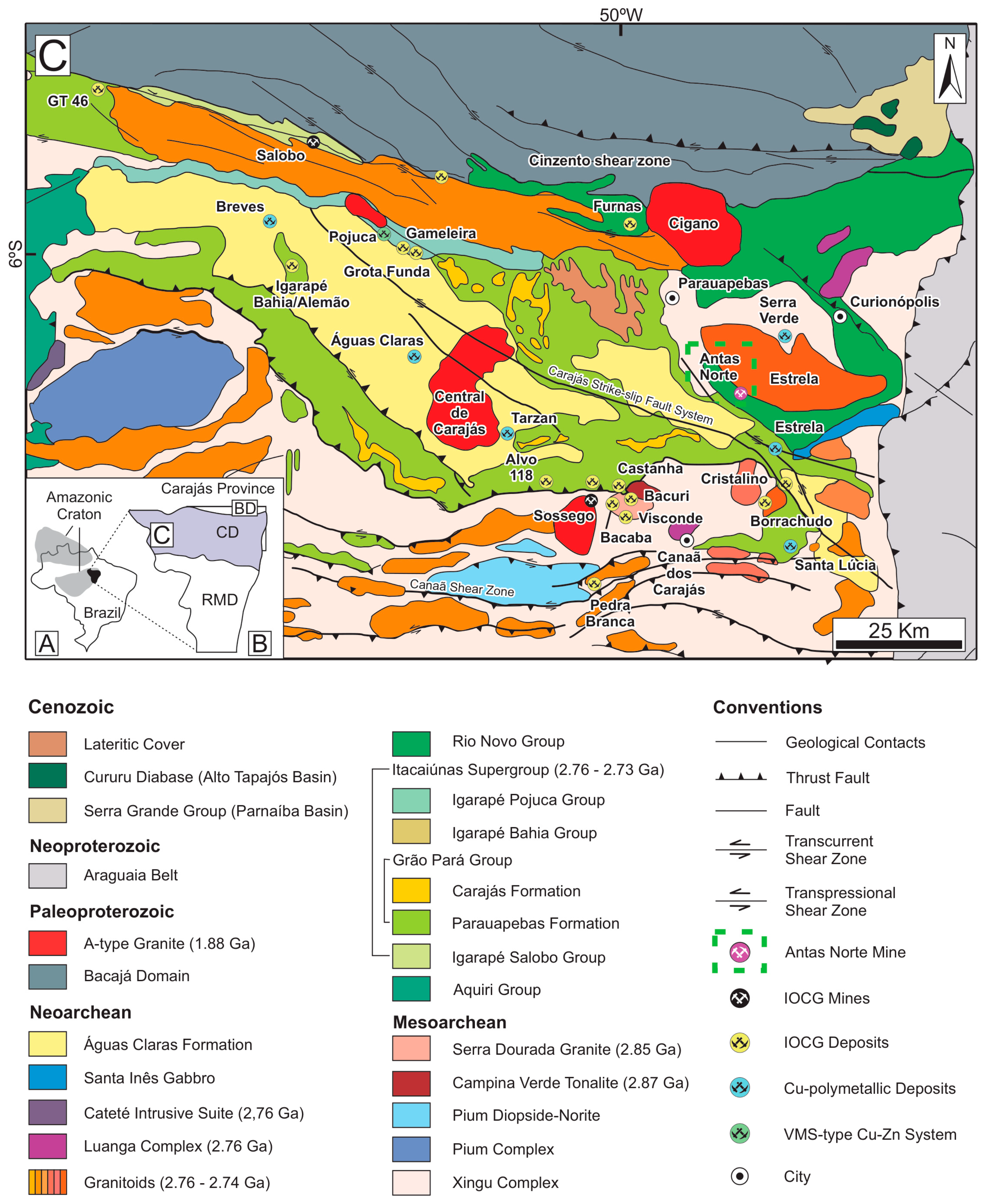
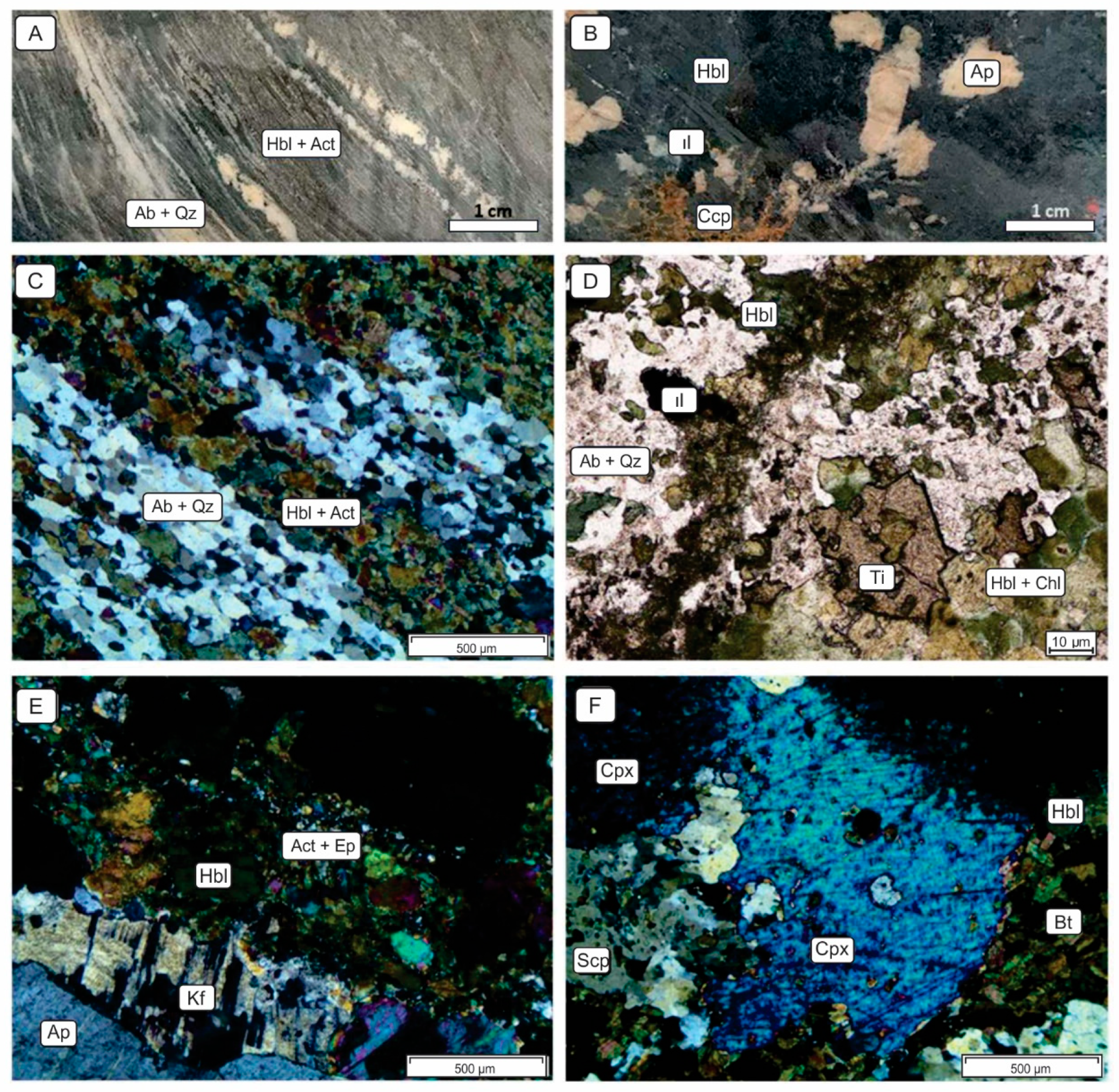
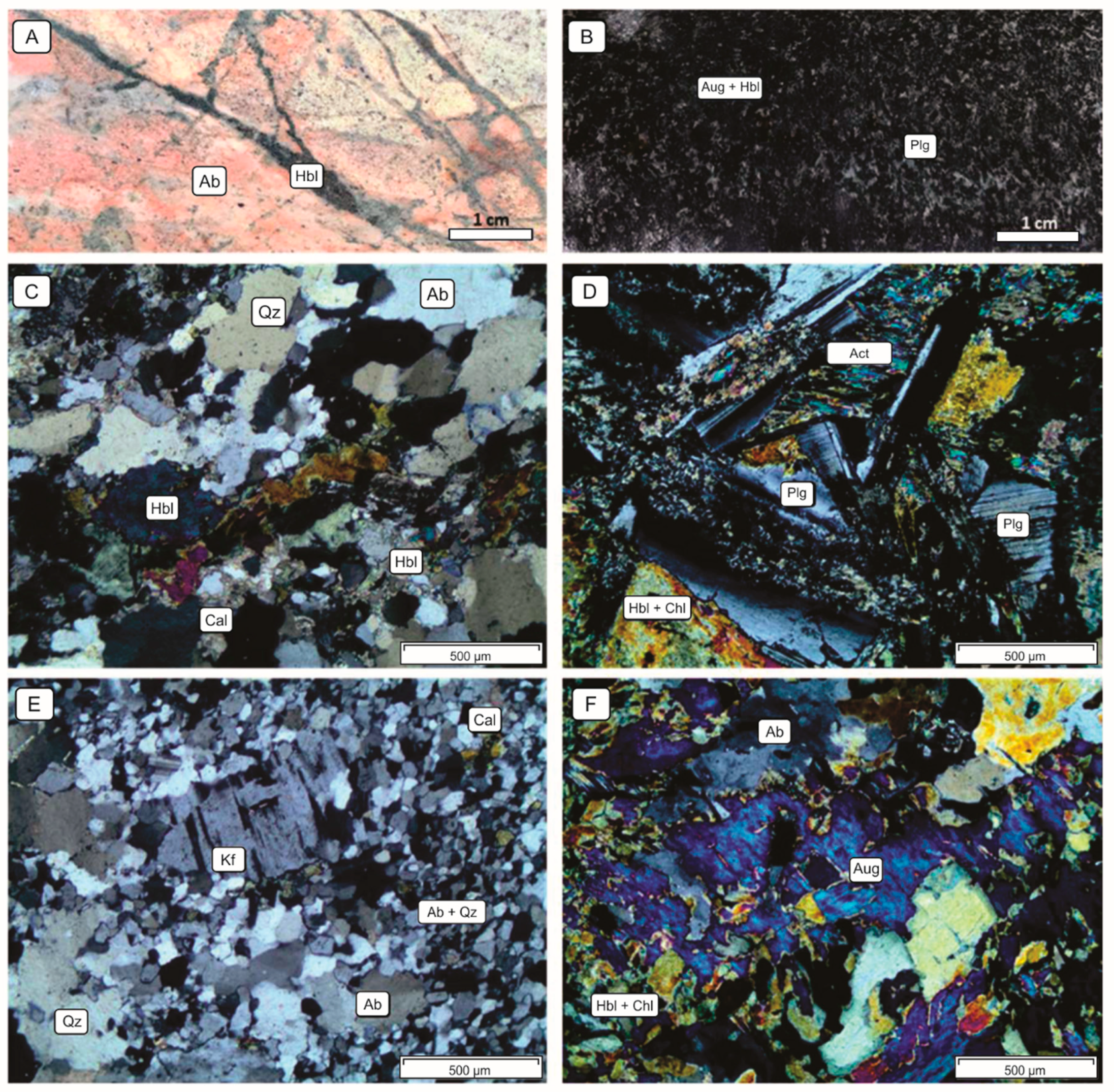
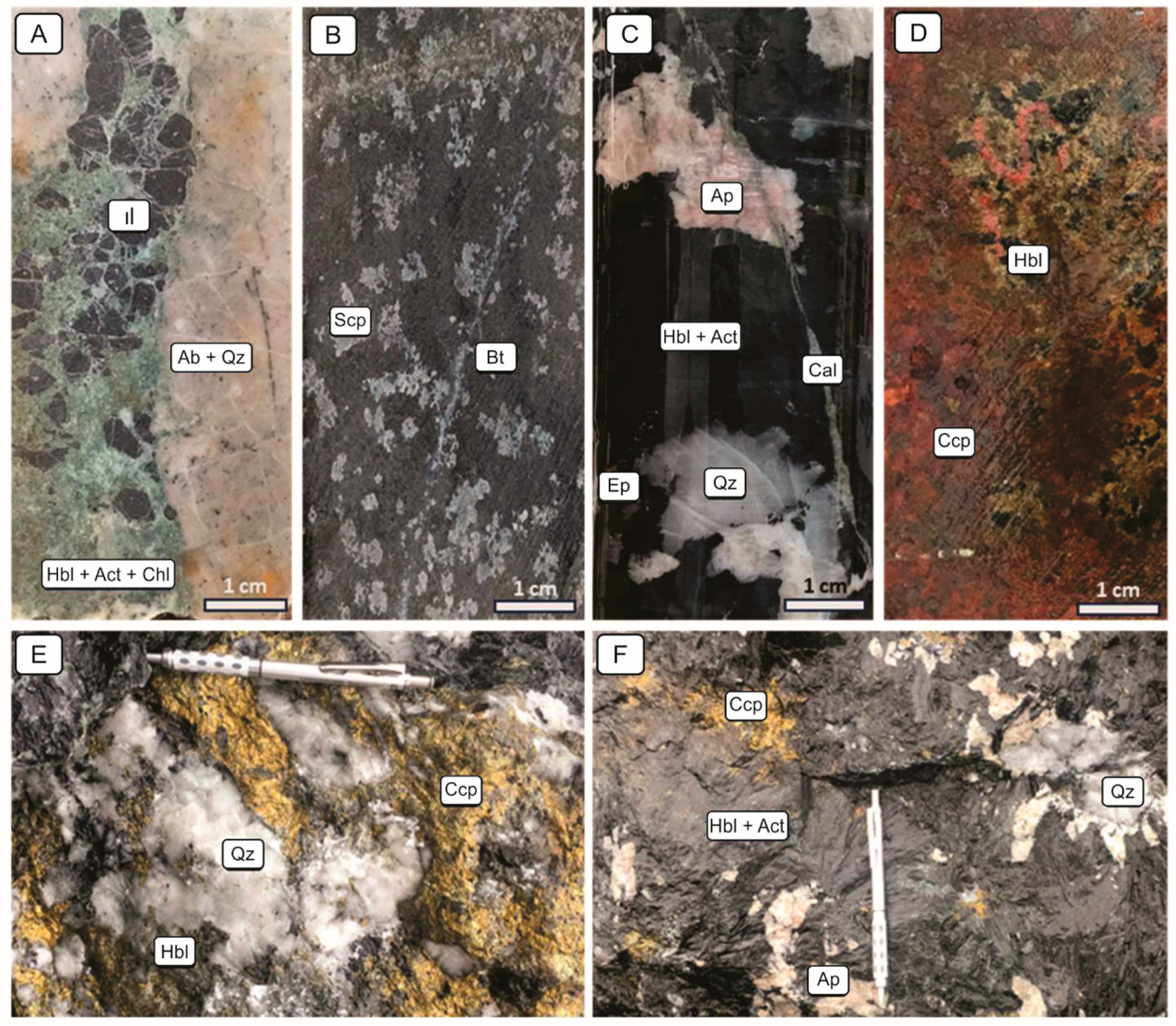


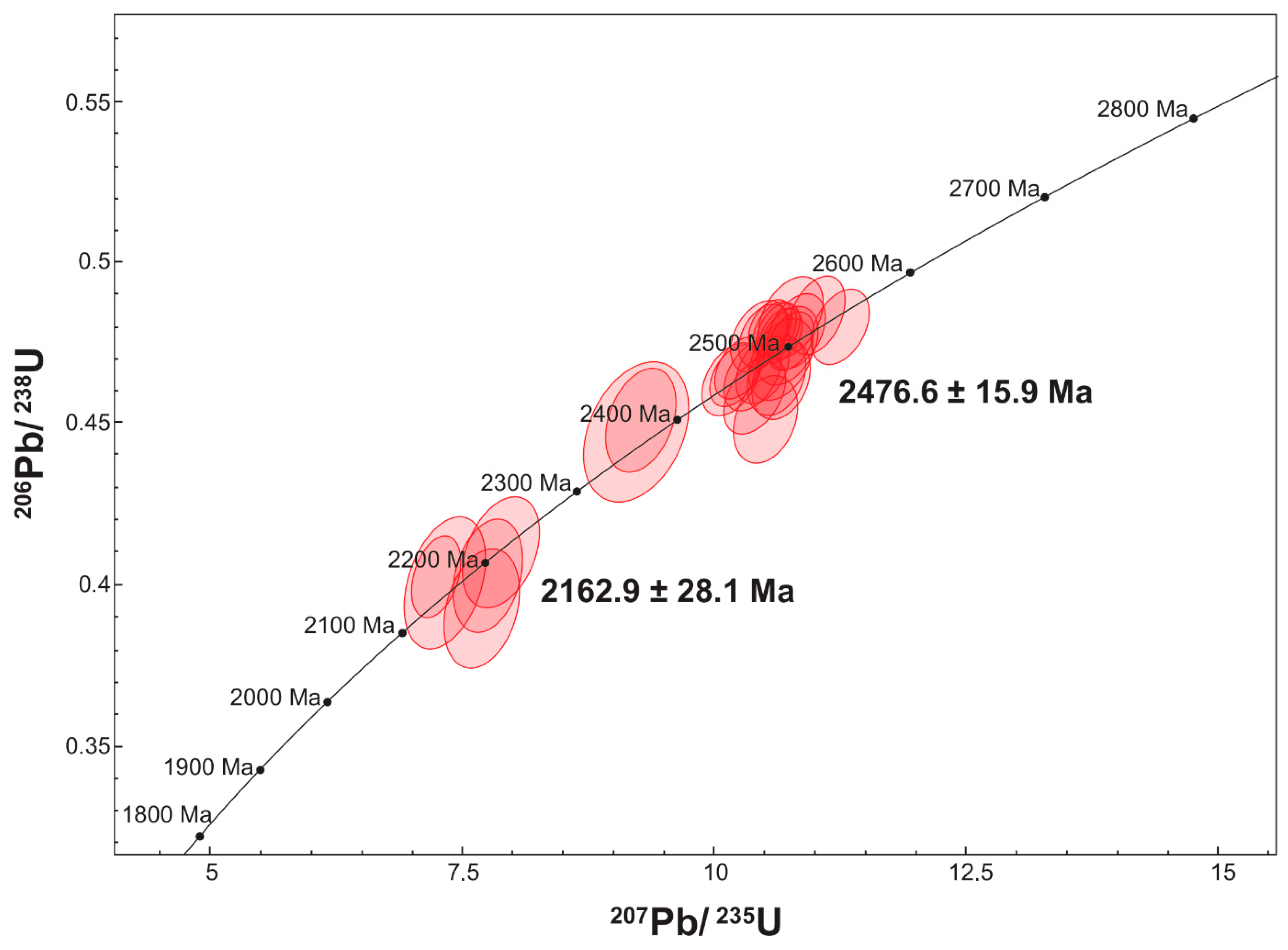
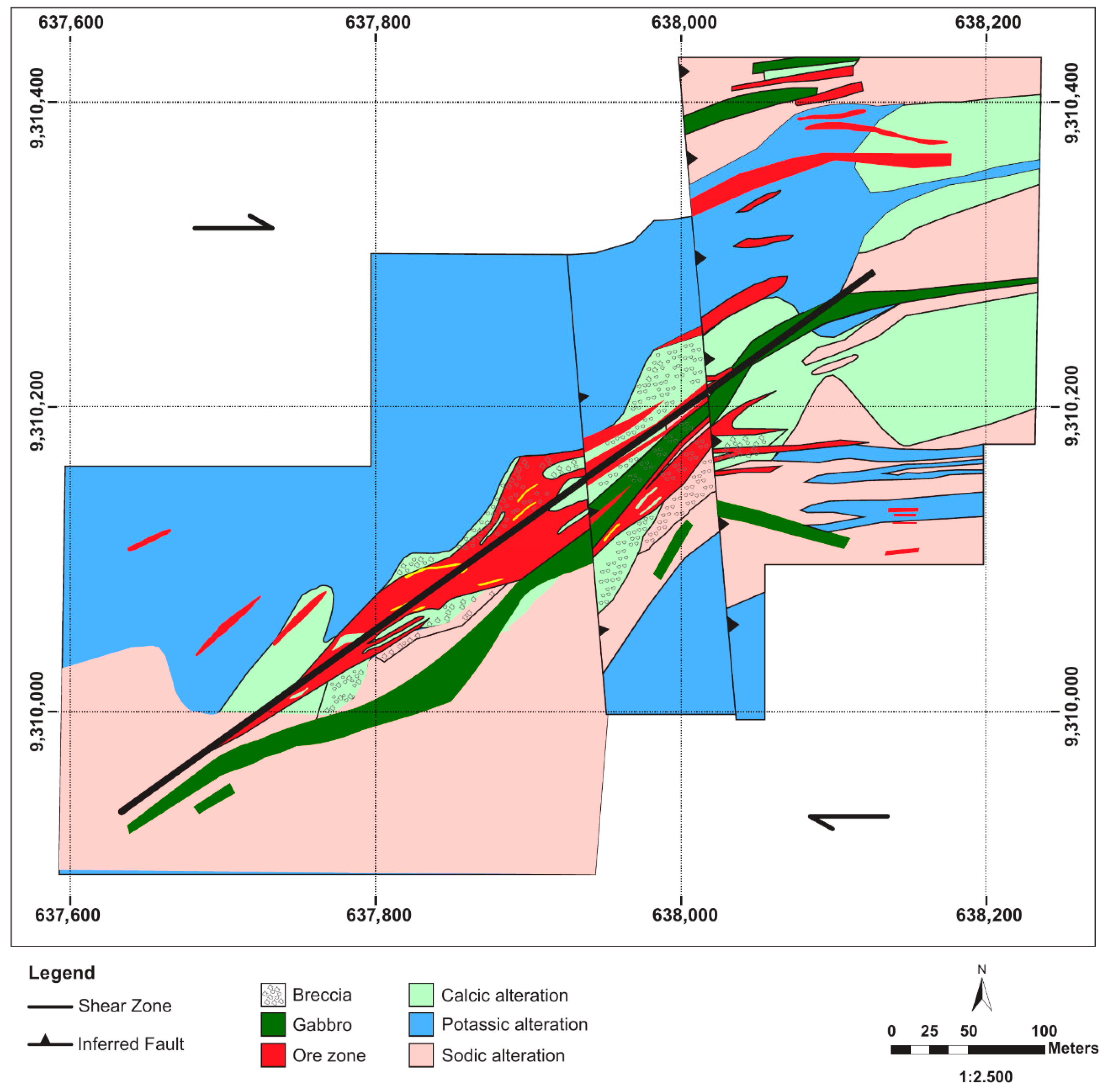
| Ages (Ma) | |||||||||
|---|---|---|---|---|---|---|---|---|---|
| Spot | 207Pb/206Pb | 207Pb/235U | 206Pb/238U | 207Pb/206Pb | ±2σ | 206Pb/238U | ±2σ | 207Pb/235U | ±2σ |
| AAND070 (SAMPLE) | |||||||||
| Spot 72 | 0.1644 | 10.383 | 0.4591 | 2478 | 43 | 2429 | 45 | 2467 | 22 |
| Spot 73 | 0.1625 | 10.448 | 0.4643 | 2469 | 27 | 2455 | 32 | 2470 | 14 |
| Spot 74 | 0.1474 | 7.709 | 0.3930 | 2209 | 79 | 2119 | 70 | 2173 | 35 |
| Spot 75 | 0.1591 | 10.156 | 0.4651 | 2441 | 28 | 2462 | 32 | 2449 | 14 |
| Spot 76 | 0.1614 | 10.224 | 0.4675 | 2452 | 28 | 2466 | 34 | 2449 | 16 |
| Spot 77 | 0.1623 | 10.337 | 0.4640 | 2461 | 35 | 2446 | 38 | 2458 | 18 |
| Spot 78 | 0.1583 | 10.558 | 0.4792 | 2425 | 28 | 2512 | 33 | 2480 | 15 |
| Spot 79 | 0.1621 | 10.503 | 0.4668 | 2460 | 32 | 2468 | 35 | 2472 | 17 |
| Spot 80 | 0.1590 | 10.555 | 0.4753 | 2444 | 24 | 2505 | 33 | 2480 | 13 |
| Spot 81 | 0.1619 | 10.359 | 0.4653 | 2460 | 41 | 2451 | 41 | 2457 | 20 |
| Spot 82 | 0.1704 | 10.499 | 0.4509 | 2522 | 50 | 2396 | 50 | 2467 | 23 |
| Spot 83 | 0.1683 | 10.653 | 0.4677 | 2501 | 53 | 2468 | 54 | 2489 | 25 |
| Spot 84 | 0.1603 | 10.476 | 0.4765 | 2440 | 36 | 2503 | 37 | 2473 | 17 |
| Spot 85 | 0.1597 | 10.416 | 0.4768 | 2431 | 39 | 2521 | 41 | 2475 | 18 |
| Spot 86 | 0.1672 | 10.679 | 0.4624 | 2519 | 36 | 2444 | 38 | 2491 | 19 |
| Spot 87 | 0.1605 | 10.129 | 0.4637 | 2438 | 37 | 2460 | 40 | 2444 | 18 |
| Spot 88 | 0.1686 | 11.244 | 0.4799 | 2535 | 36 | 2528 | 43 | 2540 | 18 |
| Spot 89 | 0.1639 | 11.003 | 0.4833 | 2475 | 39 | 2532 | 44 | 2515 | 21 |
| Spot 90 | 0.1541 | 9.229 | 0.4468 | 2316 | 96 | 2356 | 78 | 2335 | 41 |
| Spot 91 | 0.1450 | 7.759 | 0.4027 | 2185 | 82 | 2155 | 66 | 2203 | 32 |
| Spot 92 | 0.1483 | 7.894 | 0.4097 | 2282 | 74 | 2206 | 65 | 2218 | 35 |
| Spot 93 | 0.1361 | 7.341 | 0.4005 | 2077 | 104 | 2166 | 77 | 2137 | 41 |
| Spot 94 | 0.1321 | 7.257 | 0.4023 | 2064 | 55 | 2164 | 48 | 2130 | 25 |
| Spot 95 | 0.1586 | 10.755 | 0.4831 | 2435 | 43 | 2545 | 44 | 2496 | 22 |
| Spot 96 | 0.1638 | 10.757 | 0.4759 | 2483 | 45 | 2506 | 50 | 2502 | 23 |
| Spot 98 | 0.1612 | 10.788 | 0.4755 | 2463 | 26 | 2502 | 32 | 2502 | 14 |
| Spot 99 | 0.1625 | 10.650 | 0.4726 | 2476 | 53 | 2486 | 56 | 2493 | 25 |
| Spot 100 | 0.1597 | 10.451 | 0.4677 | 2450 | 31 | 2468 | 39 | 2470 | 18 |
| Spot 101 | 0.1536 | 9.266 | 0.4505 | 2312 | 58 | 2382 | 57 | 2351 | 28 |
Disclaimer/Publisher’s Note: The statements, opinions and data contained in all publications are solely those of the individual author(s) and contributor(s) and not of MDPI and/or the editor(s). MDPI and/or the editor(s) disclaim responsibility for any injury to people or property resulting from any ideas, methods, instructions or products referred to in the content. |
© 2025 by the authors. Licensee MDPI, Basel, Switzerland. This article is an open access article distributed under the terms and conditions of the Creative Commons Attribution (CC BY) license (https://creativecommons.org/licenses/by/4.0/).
Share and Cite
Hühn, S.R.B.; Paula, R.N.; Ferreira Fonseca, F.J.; Barreira, I.B. Geology and Hydrothermal Evolution of the Antas North Iron Sulfide–Copper–Gold (ISCG) Deposit in the Carajás Mineral Province. Minerals 2025, 15, 1081. https://doi.org/10.3390/min15101081
Hühn SRB, Paula RN, Ferreira Fonseca FJ, Barreira IB. Geology and Hydrothermal Evolution of the Antas North Iron Sulfide–Copper–Gold (ISCG) Deposit in the Carajás Mineral Province. Minerals. 2025; 15(10):1081. https://doi.org/10.3390/min15101081
Chicago/Turabian StyleHühn, Sérgio Roberto Bacelar, Rafael Nascimento Paula, Francisco José Ferreira Fonseca, and Isac Brito Barreira. 2025. "Geology and Hydrothermal Evolution of the Antas North Iron Sulfide–Copper–Gold (ISCG) Deposit in the Carajás Mineral Province" Minerals 15, no. 10: 1081. https://doi.org/10.3390/min15101081
APA StyleHühn, S. R. B., Paula, R. N., Ferreira Fonseca, F. J., & Barreira, I. B. (2025). Geology and Hydrothermal Evolution of the Antas North Iron Sulfide–Copper–Gold (ISCG) Deposit in the Carajás Mineral Province. Minerals, 15(10), 1081. https://doi.org/10.3390/min15101081







